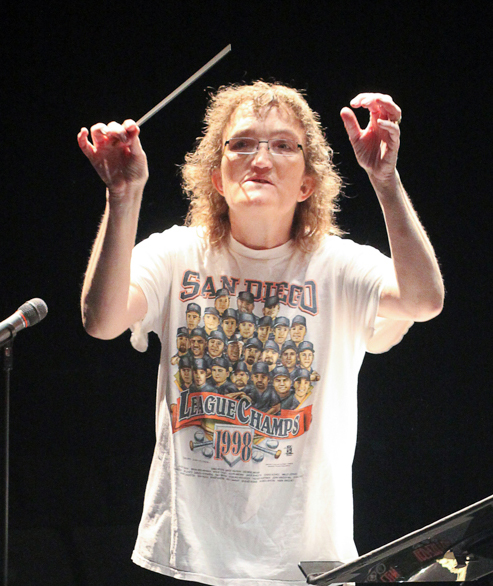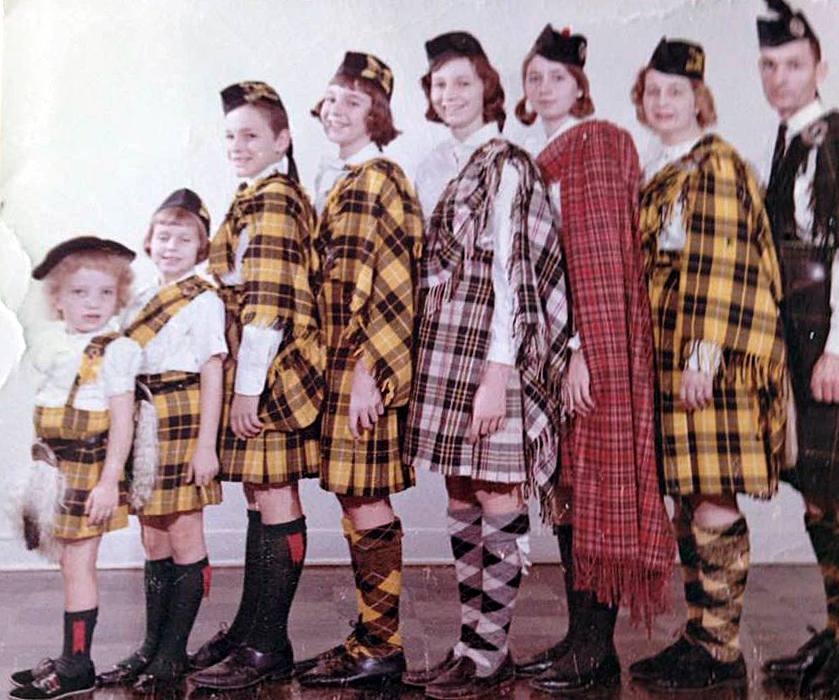Featured Stories
Heather Barclay: The Life of a Percussionist

Musical director Heather Barclay conducts the Palomar Percussion Ensemble. Photo: Coleen Burnham, The Telescope
What does it take to forge a successful freelance percussion career in San Diego for over 30 years? To find out, I interviewed percussionist Heather Barclay, whose teaching and musicianship I’ve admired ever since we worked together at Westview High School in 2012 and 2013. I recommend her award-winning youth percussion ensembles to all of my private drum and percussion students. I also admire her integrity and generosity as a colleague. Drummers might be a dime a dozen, but Heather has truly set herself apart. Read on to learn how!
San Diego Troubadour: Tell me about how you got started with percussion.
Heather Barclay: In the fourth grade, they started a music program at my school. I can’t play any wind instruments, and I didn’t want to play violin or anything. We had some drums in my house already from our pipe band; we had a Scottish pipe band in our family. And my parents said, “Do you want to go ahead and play drums?” and I said yes!
SDT: Is that a family tradition?
HB: It started before I was born. My dad is Scottish, and he wanted to play the pipes. We’re a family of six kids; he had the means to actually do something like that, so my father played lead bagpipes, and my mom played the bass drum. My two oldest sisters played bagpipes as well, and the twins played snare drums or tenor drums. And then my next sister up from before me, and then myself; we carried the little banner to march in parades. I can honestly say I started marching when I was two years old!

The Barclay Family Pipe Band.
SDT: What was it like growing up in a family where you all played music together? I’m thinking about the Selena movie, where their dad has to yell at them to practice—was it like that?
HB: Well, later on in life! [laughs] But no, I think we all enjoyed it. It was a lot of work, but it was a lot of fun, and we all love music. When I first started playing percussion in the fourth grade, I had no problem practicing, because I loved it so much, and I just kept playing. I even had a little solo in front of the whole band in fifth grade. And, of course, I wore my kilt!
SDT: At what point did you decide that it was what you wanted to do professionally?
HB: In high school when I started taking private lessons; I think I was a junior in high school.
SDT: And that was in Wisconsin?
HB: Yes. Port Washington, Wisconsin—a half hour north of Milwaukee.
SDT: Are you a Packers fan?
HB: Yes! It’s illegal to be from Wisconsin and not be a Packers fan.
SDT: So, what brought you to San Diego?
HB: I came out here to get my master’s degree at USIU, which is now Alliant [International University]. It’s is a lot warmer here than the frozen tundra of Wisconsin, so I stayed out here.
SDT: And when you went to college, did you major in music?
HB: I did… undergrad and master’s.
SDT: When we say “percussion,” that means a lot of different things. What instruments do you play?
HB: Pretty much almost anything in percussion. I am not well-versed in world percussion, but I can play it if I’ve worked on it. When I was younger, my favorite instrument to play was keyboard—marimba, xylophone, and bells. Now, I have to work harder on those, so I’ll just go ahead and play timpani [also known as kettle drums] and snare drum.
SDT: How did you start playing the mallet percussion instruments?
HB: Well, I was homebound taught when I was in the latter part of my eighth grade and freshman year. I wanted to take band, and the band director said, “We’ll have her learn to play the keyboard instruments,” so he sent up a little bell kit with my homebound teacher. Well, I outgrew that within about a month, so then he sent up a xylophone; they bought a new xylophone for me! So, I played that, and then they brought up a marimba in a dump truck.
SDT: Oh, my God!
HB: They didn’t know how to transport it! They brought it up the front hill to get into our house, and I had a marimba after that. So that’s how I learned.
SDT: And then when did you start playing timpani?
HB: When I started lessons, so sophomore or junior year.
SDT: How do you manage the balance between teaching and performing?
HB: Well, since COVID, it’s gotten more challenging, because I’m presented with more playing opportunities. Sadly, due to the pandemic, the numbers have dropped down in a lot of music programs, so I don’t have as many private students as I had before. I can manage that somewhat, but then I’ve also started a position as a band director at Palomar College, and then, of course, I have my gigs. So, it can be very challenging, and you try to keep everything equally balanced. You have to be really on your toes to realize what has to be done in order to facilitate each area of your career.
It’s funny, because I did a rehearsal last night, and I was going, “Okay, the goal is to see the in-laws in the beginning of July,” and then all of a sudden last night I’m going, “Oh, man! I’ve got a rehearsal when we’re supposed to be over there,” so now I have to deal with that. So, it’s hard in scheduling aspects.
SDT: What are some of your favorite performances over the course of your career?
HB: Two weekends ago, I played a piece with Escondido Choral Arts that had a huge djembe solo in it. Man, that was a blast! It had seven or eight movements, each in a different language using instruments typical of that country. It’s called Jubilate Deo by Dan Forrest. I’m really proud of that one.
I love playing Carmina Burana [a famous work for choir and orchestra by Carl Orff]. I’ve never played it with a complete section of seven people; the only way I’ve played Carmina Burana is with four people, so we’re moving all around. And back in the 1990s, I played it down in Mexico. It was just so much fun. They put us up in hotels, and we got to play in front of some really appreciative audiences.
SDT: How does your performance work impact your teaching work?
HB: It makes me realize what I need to teach the kids, so they practice smart: don’t go over the stuff you already know how to play. Practice scales and arpeggios, because so much of that is in the melody when we’re playing keyboard percussion. If you know all of that, you’re going to be able to play without problems, especially in orchestral work. Focus on dynamics and blending with the group that you’re playing in. You don’t want to stick out unless it’s a big solo; you want to support the group. That’s also helped me with my percussion ensemble and in my band as well: blending to get a nice sound out of the whole group.
SDT: Do you have any students of whom you’re particularly proud?
HB: I had a student who is now pursuing a bachelor’s degree at UNT, the University of North Texas [renowned for its music school]. I had a student who went to UCLA and also USC. I’m very proud of them for pursuing their music. I had a student who was up in Denver; boy, they started a really strong percussion program up there—it’s amazing! A lot of diversity. I’ve seen my student play online, and I like what I’m seeing.
I teach the percussion ensemble at Mesa Verde Middle School. We played Technology [a percussion ensemble piece by Jim Casella], and those kids just played so well. They are such a team. If somebody’s having trouble getting the setup ready and trying to start rehearsal, the other kids—and this is something that I really promote—will help them. I say, “Take care of yourself first, and then if you have time, go help others set up,” and they do. They’re just an amazing bunch of kids.
SDT: I remember at one point you were doing a high school percussion ensemble that was based out of Palomar College, and it won a bunch of awards, right?
HB: It did. I have to include the Palomar Youth Philharmonic Orchestra Percussion Ensemble—now known as Percussive Wave—as one of my proudest moments for performances. In 2019, we entered the American Prize: Ernst Bacon Memorial Award for the Performance of American Music. We played Fidget by Nathan Daughtrey and Sofapilla by Chuck Ricotta. We had in our division UNT, Berklee, and Eastman [all well-respected college music programs], and we placed third!
SDT: That’s HUGE!
HB: Yes, it is, and I was so proud of that. I really talked that up when we were still all together. I said, “Look at what we did—WE did this!” and they were really happy. It’s not like kids from the same school; there were kids from a lot of different schools in the group. Some of them had no clue who the other people were when they first started. And then they became good friends, and I still see them talking to each other on Facebook, and, well, whatever they do, TikTok or who knows!
SDT: What advice would you give to somebody who wants to go into percussion professionally?
HB: I am not shy about telling them this is a challenging career, and you have to be able to network. You have to be able to work with people and be flexible and know how to work with money. There are going to be times when that money is not coming in, and they’ll have to find a part-time job or a full-time job or however you want to handle it. It’s not easy being a musician, period.
I don’t try to talk them out of it, because I heard somebody do that once. I felt so disappointed; there’s a whole bunch of my kids sitting there, and they’re all so excited to meet this person, and that person said, “Don’t go into music, you’re gonna hate it.” I was just like, “I know you might want to think you’re a realist, but why are you dashing these kids’ dreams?” Then, one of the kids in that group didn’t listen and still went on into music… and are doing well.
I think a lot of these kids don’t understand the amount of time that practicing takes up. And that was where I failed as far as keeping myself healthy, because I would practice four to eight hours a day, and I didn’t take breaks. So, here I am standing in front of the marimba, and I’m not bending my knees. I’m rigid and I’m playing, and what do I have? The worst back injury in the world, and I’m in physical therapy now with it.
I don’t think they understand the amount of commitment that’s involved to get into this career; it is not easy at all. But it is fun when you start being rewarded for all of your work. That’s the thing I like about the career that I have now—I’m able to not get stuck in one thing. I’m able to teach, I’m able to perform, and I’m able to conduct. And I get to travel at times—that’s a lot of fun for me. That’s the life of a percussionist!
This interview has been edited for length and clarity.






